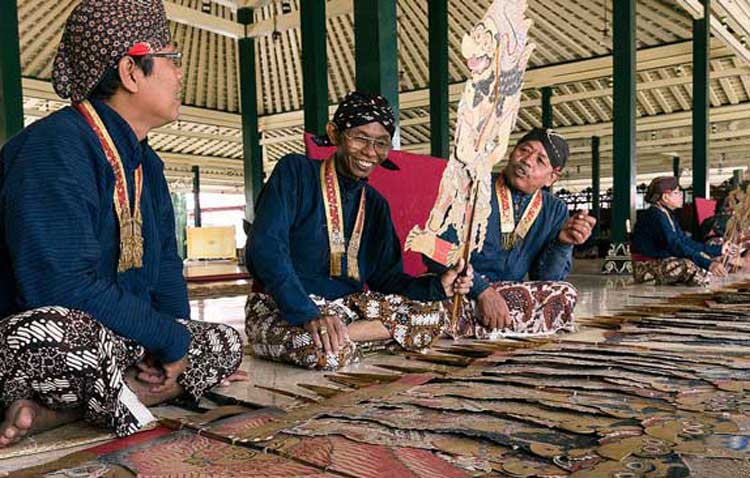
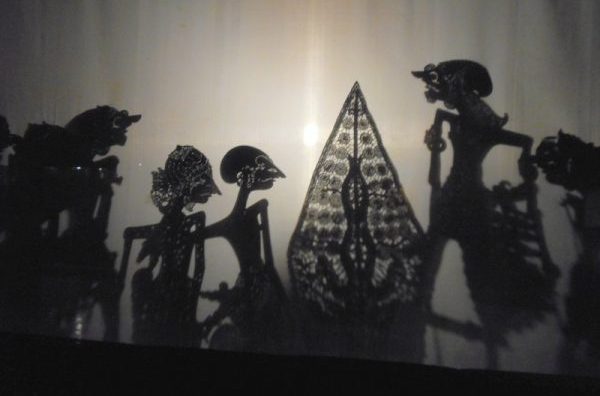
A mere stroll triggered beads of sweat to form and trickle down my face.
The oppressive 90 degree heat and 97 percent humidity during my travel in Semarang, Java, Indonesia dampened everything but the spirit of adventure.
Intrigued by the distinct sound of Javanese music, I followed clanks of gongs, thuds of drums and high pitched soprano voices.
Like sirens, the shrill tunes guided me through the stifling, leaden air.
The mysticism pervasive in this land of a multitude of ancient Hindu and Buddhist Gods, plus Java’s predominant Muhammad of Islam drew me toward a temple-like structure with open-air sides.
As the pageantry unfolded, there it was — the event I most wanted to experience in all of Indonesia.
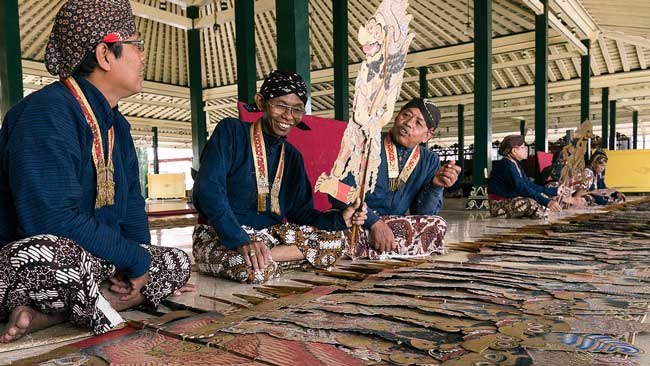
Shadow Puppet Theater in Indonesia
Having scant knowledge about the cultural nuances of this island nation, I watched the 1982 film, “The Year of Living Dangerously,” starring Mel Gibson, Sigourney Weaver.
Best Supporting Actress/ Oscar Winner Linda Hunt while sailing from Singapore to Indonesia. I had seen this film before, but had apparently paid little attention.
Now, with a specific purpose, I felt captivated by the opening scenes of dark images moving behind an opaque screen.
I listened with a keener awareness to the advice that Hunt’s character, Billy Kwan, a local Javanese photographer, gave to rookie Australian journalist, Guy Washington, who arrived in 1965 to report on the toppling of Sukarno, Indonesia’s first president.
Puppet Play
In an attempt to enlighten Guy about the country’s complex cultural make-up, Billy said, “If you want to understand Java, you have to understand the sacred ‘shadow (puppet) play’.
The puppet master is a priest, balancing the left with the right. The shadows are souls and the screen is heaven. You must watch their shadows, not the puppets.
The right is in constant struggle with the left; the forces of light and darkness in endless balance.”
She continued, “In the West we want answers for everything. Everything is right or wrong or good or bad.
But in the shadow play, no such final conclusions exist. Good always triumphs, but evil is never destroyed.”
I wanted to understand Java and Bali and the rest of this archipelago nation of 17,000 islands, 6,000 inhabited. Billy Kwan’s quotes gave me the clue. I had to attend a shadow puppet play.
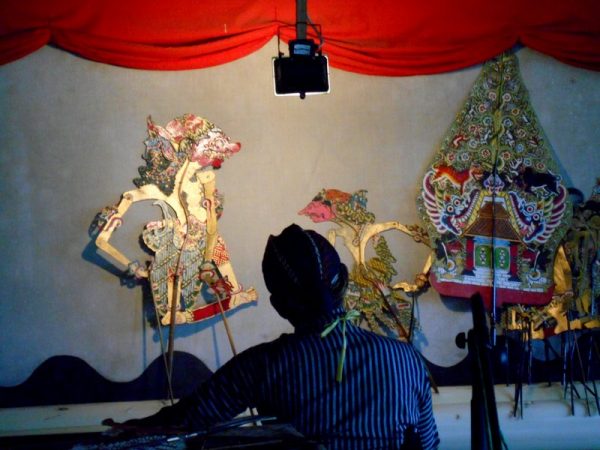
Live performance of a wayang kulit
The Gods must have helped me to stumble upon one, because magically I stood in the midst of a live performance of a wayang kulit.
Wayang comes from the Indonesian word for ‘shadow’(bayang) and kulit refers to the use of buffalo hide to make the flat puppet figures with movable joints, animated by hand, using rods connected to their appendages.
Indonesian Shadow Puppet Theater, originating in 800 A.D. and considered the oldest freestanding puppet form, tells stories of heroic ancestors of Javanese Kings, quests, battles, ogres and scenes of romantic love.
This ancient form of storytelling can last up to six hours for one performance, and uses cut-out figures, held in front of an illuminated backdrop to create the illusion of moving images.
Oil lamps used to provide illumination, now modern halogen bulbs act as the lighting source. Although shadow play is performed throughout the Indonesian Islands, it remains a principle expression of the arts in Semarang, Java and Bali.
In 2003, UNESCO designated Indonesian wayang kulit as one of the Masterpieces of Oral and Intangible Heritage of Humanity.
Entering the Theater
When I entered the theater through the rear entrance, the unique ensemble of participants required for every shadow puppet play unfolded before me and feelings of reverence filled the space.
Standing no more than 15 feet from the ‘behind the screen’ activity, I felt like I was in the midst of a Broadway play, surrounded by the director, actors, the orchestra and singers.
The dalang, the puppet master, squatted on bended knees in front of the huge sheet-like screen, illuminated by a hanging bulb.
He is the key to all shadow play — the music conductor, the epic storyteller, the comic, philosopher and political pundit. A huge collection of brightly colored metal puppets lay in a heap on either side of him.
As he told the story he sifted through the pile to find the characters needed for the scene. He manipulated the figures to dance, walk, laugh and cry as he held them against the partition.
Changing voice tones to speak the words of each individual puppet, his ability to act out every role captured my complete attention.
As I watched, the mood of the play suddenly changed. The dalang snatched two warrior-like puppets and slammed them against the white backdrop with such force, that it caused a small tear in the screen’s cloth.
As he bellowed loud, angry sounding words, he made the puppets fight each other in fierce battle, using only one hand to manipulate both.
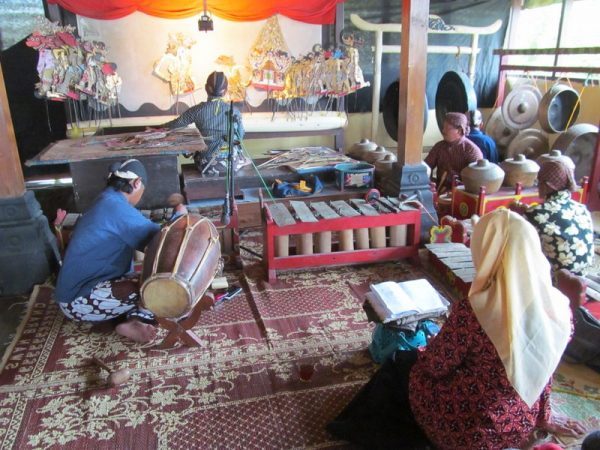
With the other hand, he grabbed a rounded piece of wood, smoothed and molded by years of being clutched in his grasp and rapped the wooden wand against the floor in a distinctive beat.
Orchestra
A signal for the percussion orchestra known as the gamelan and female chorale singers known as sendhin to provide intense background music.
The instrumental ensemble included metallophones pounded with mallets, xylophones, and bamboo flutes.
With cord-wrapped sticks, a musician struck 10-14 horizontal and hanging, bronze cast gongs with centered, rounded nipples, made in various sizes to produce different scale tones.
Hand played drums called kendhang and a bowed instrument called a rebab completed the orchestra.
A gamelan accompanies all Indonesian puppet performances; the music is improvised and features complex harmonies and rhythms. Being an integral part of Indonesian culture, it predates Hindu-Buddhist times and believed to have been created about 230 A.D.
All the musicians, including the female vocalists sat back on their heels throughout the performance. I sensed their discomfort, as I realized I could never maintain that position for six hours and then get up and walk with ease.
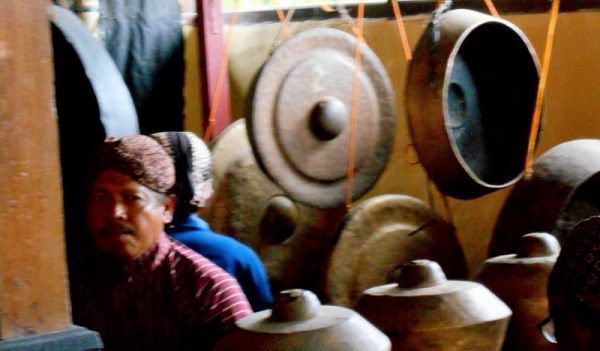
Mesmerized by the intricacies of these players, I realized that I wasn’t following Billy Kwan’s advice. I hadn’t watched the play from the audience side of the screen.
I neglected to study the shadows of the moving puppet images, because I was too fascinated by the actual movements that the puppet master directed.
Flat characters are brought to life by the dalang, who has a repertoire of hundreds of stories, and incorporates the happenings of the local village into each shadow play.
The audience receives knowledge from the dalang and uses what is learned to benefit the community. The people believe that the puppets have spiritual powers.
One, Semar, the principle jester used in all performances, is said to be the spirit of the island of Java and can heal and protect them.
They have faith that ancestral spirits can inhabit the puppets and the gongs, considered an integral part of every performance.
The development of wayang kulit blossomed during the Hindu-Buddhist period from 800-1500 A.D. using Sanskrit-based words and stories centered on great Hindu epics.
However, when Majapahil, the last Hindu-Buddhist Kingdom on Java fell around 1500 A.D., Chinese Muslims migrated to Java, making Islam the primary religion there.
Most Javanese Hindus fled and took up residence on Bali. This transition dramatically changed the fabric of Indonesian shadow puppetry.
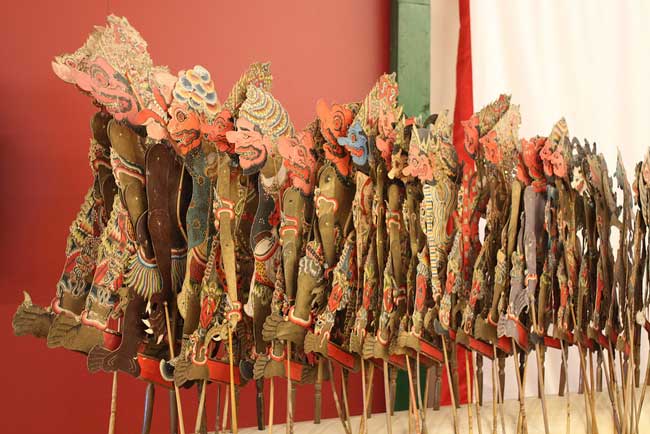
On Java, the puppet master believes that wayang relates how Javanese people converted to Islam. Although the stories still encompass Hindu elements, most Javanese dalangs are Muslim.
Wooden and metal puppets on Java reflect the influence of the Chinese; Bali still uses leather ones to tell Hindu-based stories. Puppets on Java have distorted body shapes, because Islam precludes making exact images of the human body, while Balinese puppets are more naturalistic.
The Javanese puppet master demands a slow, meditative style, while Balinese puppets move faster with louder music.
After an hour, I took leave of this 1200-year-old Indonesian art form, but the dalang, the gamelan and the sendhin showed no signs of stopping.
I didn’t completely understand the complexities of Indonesia’s history, but I knew that ancient shadow puppet theater had helped to make thousands of islands strung out across the Indian Ocean and Java Sea into a cohesive nation.
Author Bio: After a life-long profession of treating the mentally ill at a PA psychiatric hospital for 33 years and also serving as its Director of Admissions, Carol retired to Lake Chapala, Mexico in 2006 with her husband, to pursue more positive passions. Her family thought that she, too, had ‘gone mad.’ She’s been teaching English to Mexican adults for ten years, in a program operated by volunteer expatriates and writing for local on-line and print publications. Using her adventures experienced during visits to over 80 countries to capture a niche in travel writing, Carol also dabbles in ‘memoir.’ A frequent contributor to Lake Chapala English magazine, “El Ojo del Lago,” she’s won several literary awards from that publication, including Best Feature in 2010 and Best Fiction in 2014. She also netted a story regarding her psychiatric field work in the published anthology, “Tales from the Couch.”
- What It’s Like to Live as an Expat: Lake Chapala, Mexico - April 18, 2024
- Top 5 Spots for Stargazing in North Carolina - April 17, 2024
- The Low-Key Magic of Ghent, Belgium - April 17, 2024
